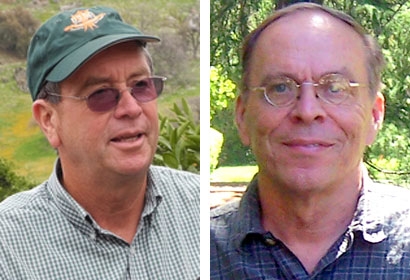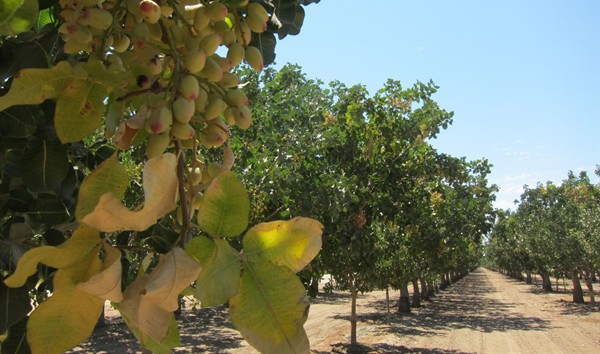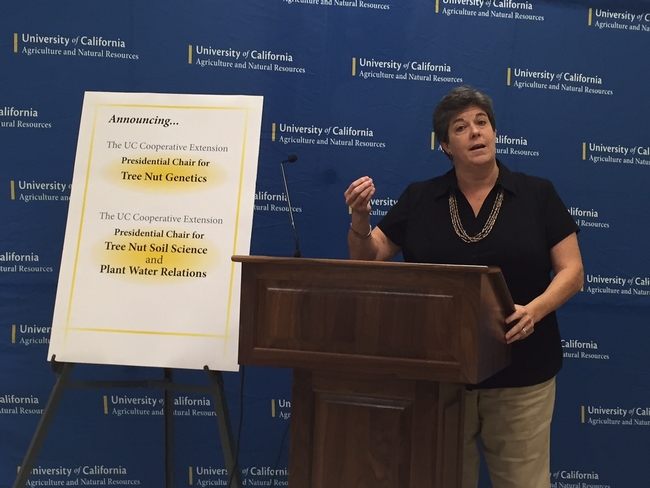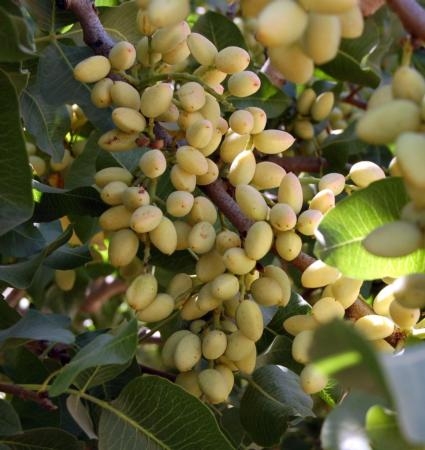Posts Tagged: pistachios
UC ANR announces recipients of first two $1 million endowed chairs
The UCCE citrus and pistachio crops advisor in Kern County, Craig Kallsen, is the UC Cooperative Extension Presidential Chair for Tree Nut Genetics, and UCCE integrated orchard management specialist Bruce Lampinen, based at UC Davis, is the UC Cooperative Extension Presidential Chair for Tree Nut Soil Science and Plant Water Relations. The endowed chairs will give the two scientists a dedicated source of funding for five years, when the chairs are reopened for review.
UC ANR established the two $1 million endowments for the endowed chairs last year. Half the funding was provided by UC President Janet Napolitano; the other half was donated by the California Pistachio Research Board. Establishment of the endowed chairs was announced last year by UC ANR vice president Glenda Humiston.
“I'm pleased that we have identified two exceptional research programs to support with the first endowed chairs in the more than 100-year history of UC Cooperative Extension,” Humiston said. “I feel certain Craig and Bruce will make significant advances in pistachio production systems under California conditions.”
Pistachio breeding program
Kallsen said the endowment comes at a particularly opportune time for the UC pistachio breeding research program. In cooperation with UC Davis pomology researcher Dan Parfitt, Kallsen has been breeding pistachios as part of a variety selection program using conventional methods - manually crossing and then growing trees to determine whether they have beneficial characteristics.
“Breeding new varieties this way takes a while, especially in pistachios,” Kallsen said. “They don't bloom for four or five years. With some trials we are just now at the stage where it gets interesting. The funding will be helpful for evaluating the new progeny.”
Kallsen is looking for pistachio varieties that show novel nut, tree growth and yield characteristics, and for varieties that produce a high yield even under low-chill conditions.
“The climate appears to be warming,” Kallsen said. “That poses a problem for pistachios, because our current cultivars have a significant chilling requirement that has not always been met when we don't have cold, foggy winters.”
Kallsen plans to establish a trial pistachio orchard at the UC Riverside Coachella Valley Agricultural Research Station, where winter weather rarely dips to sufficient chill levels, to see which varieties produce acceptable crops under the warmer conditions.
Another key objective of the UC breeding program is identifying pistachio cultivars that mature at different times. At the moment, 90 percent of California pistachios are the Kerman variety. They all mature at the same time, putting pressure on harvesting, transportation, processing and storage resources.
“Ten years ago, UC introduced the Golden Hills variety, which matures about two weeks earlier. It now represents 5 or 10 percent of the state's crop,” Kallsen said. “We're looking closely at another potential cultivar that matures 10 days before Golden Hills.”
Pistachio research at UC Davis
Lampinen has devoted most of his career to almond and walnut research, but has worked on pistachios in collaboration with other UCCE specialists and advisors since 2009, focusing mainly on canopy light interception and salinity and their impacts on pistachio yield and water use.
Lampinen said his current work on almond and walnut water use as related to canopy size will be expanded to pistachio with the funding from the endowment.
“Some preliminary data on this is currently being gathered, but there is a need to expand this work to a wider range of orchard ages and planting configurations,” Lampinen said. “It will be very useful to have the ongoing support from an endowment.”
Lampinen's work in almonds and walnuts will also inform new pistachio research approaches. For example, Lampinen developed a no-pruning system for establishing new walnut orchards, and will study whether a similar approach in pistachio would make sense. For decades, California farmers believed that pruning young walnut trees was critical to healthy tree development. Lampinen observed unpruned walnut orchards in France, and “they looked perfectly fine,” he said.
Lampinen's research showed that pruning in the early years of tree development reduced water use efficiency and decreased walnut yields. By not pruning young trees, farmers could cut back significantly on labor costs and eliminate the need to dispose of the vegetation cut off the tree while using water more efficiently.
The no-pruning approach is now widely accepted in almonds and walnuts. With funding from the five-year endowment, he plans to compare the impacts of the alternative pruning systems on newly established pistachio orchards.
In addition, Lampinen said he plans to consult with pistachio industry leaders, growers and farm advisors to develop an effective research program on pistachio soil and water relations.
New cost and return study for pistachios by UC ANR Agricultural Issues Center
The study focuses on establishing an orchard and producing pistachios under low-volume (drip) irrigation in the southern San Joaquin Valley counties of Fresno, Kern, Kings, Merced and Tulare.
The economic life of the orchard used in this cost analysis is 40 years. The analysis is based upon a hypothetical farm operation of a well-managed orchard, using practices common to the region. Input and reviews were provided by growers, UC ANR Cooperative Extension farm advisors and other agricultural associates. Assumptions used to identify current costs for the pistachio crop, material inputs, cash and non-cash overhead are described. A ranging analysis table shows profits over a range of prices and yields. Other tables show the monthly cash costs, the costs and returns per acre, hourly equipment costs, and the whole farm annual equipment, investment and business overhead costs.
The new study is titled “2015 Sample Costs to Establish a Pistachio Orchard and Produce Pistachios Under Low-volume Irrigation in the Southern San Joaquin Valley-South.”
This study and other sample cost of production studies for many commodities can be downloaded for free from the UC Davis Department of Agriculture and Resource Economics website at http://coststudies.ucdavis.edu.
For additional information or an explanation of the calculations used in the studies, contact Don Stewart at the Agricultural Issues Center at (530) 752-4651 or destewart@ucdavis.edu.
UC ANR establishes two endowed chairs in Cooperative Extension
UC Agriculture and Natural Resources (UC ANR) has established two $1 million endowments and is now preparing to select the recipients of its first-ever endowed chairs in Cooperative Extension, announced UC ANR vice president Glenda Humiston today (Oct. 29). The endowed chairs will give two scientists a dedicated source of funding for their ongoing agricultural research.
Half the funds for the endowed chairs was provided by UC President Janet Napolitano; the other half was donated by the California Pistachio Research Board. One is the UC Cooperative Extension Presidential Chair for Tree Nut Genetics; the other is the UC Cooperative Extension Presidential Chair for Tree Nut Soil Science and Plant Water Relations.
“The establishment of endowed chairs represents an historic occasion for UC ANR and is something we've never before enjoyed during the 100-years UC ANR Cooperative Extension has served California,” Humiston said. “The pistachio industry's contribution demonstrates its high level of confidence in our research and outreach program, and President Napolitano's match shows her recognition of the work we do not only on campuses but throughout UC ANR.”
UCCE is the applied research and outreach arm of the University of California that serves the agricultural industry, coordinates the 4-H program, supports natural resources stewardship, and provides nutrition education programs throughout the state.
The California Pistachio Research Board has a long history of funding ANR research. Since its establishment in 2007, the program's donations have totaled more than $3 million. Relative to other major California commodities, pistachio production is new. The first commercial crop was produced in 1976. In 2014, farmers harvested 519 million pounds of pistachios, valued at $1.8 billion.
Tom Coleman, a Fresno County pistachio farmer and chair of the Pistachio Research Board, said he enjoys informally comparing notes with other growers, but that doesn't substitute for scientific research.
“I find it absolutely invaluable to have good scientific research to apply on our farms,” Coleman said. “With impending changes in our water situation and a changing climate, research is really our only option.”
In fact, the industry has already felt the impact of climate change on yield. The pistachio growers expect the 2015 yield to be nearly 50 percent lower than the previous year, in large part due to a lack of sufficient winter chilling and water supply cuts, said Bob Klein, manager of the California Pistachio Research Board.
“We know that our future is going to look better with more research as we face the challenges of a warming climate and less water,” Klein said.
Napolitano created the Presidential Match for Endowed Chairs last year for UC campuses and UC ANR to use as an incentive to encourage donors to establish endowed chairs to fund research. Endowed chairs help attract and retain top-flight academics. Once established, endowed chairs provide a dedicated source of funds, in perpetuity, for the chair holder's scholarly activities.
“Donors who endow chairs are helping support the agricultural industry today, and contributing to future growth, innovation and success,” Humiston said. “We hope to establish more endowed chairs in UC Cooperative Extension with the help of our partners.”
View the announcement in the 12-minute video below:
$1.5 million donated to hire UCCE specialist
Thanks to a gift from the California Pistachio Research Board, UC Agriculture and Natural Resources will soon be hiring a new UC Cooperative Extension specialist, announced Barbara Allen-Diaz, University of California vice president for Agriculture and Natural Resources.
The Pistachio Research Board will donate $1.5 million to support a UC Cooperative Extension specialist to conduct nut and fruit disease research. This specialist position, which will be based in the Department of Plant Pathology at UC Davis and housed at Kearney Agricultural Research and Extension Center in Parlier, will help UC ANR fulfill its mission as well as serve the pistachio industry’s needs.
“On behalf of California’s pistachio growers, the California Pistachio Research Board is pleased to invest in the research and extension activities of the University of California and particularly UC Cooperative Extension,” said Bob Klein, manager of the California Pistachio Research Board.
“California farmers, especially pistachio growers, know that research is needed to maintain and improve food production while using our resources wisely and sustainably,” he said. “This position will help address the ever-changing plant disease spectrum in the state, as well as respond to new regulations on both the state and federal levels.”
“The nut and fruit crop pathology specialist was identified as a priority position for UC ANR in our position planning process, and the Pistachio Research Board’s generous gift and foresight enables us to begin recruiting immediately,” Allen-Diaz said. “The board’s six-year commitment gives the position stability. After six years, UC ANR will assume financial responsibility for the position.”
This is the third UC Cooperative Extension academic position funded through a partnership between the agricultural community and UC ANR. The California Rice Research Board and the California Table Grape Commission were the first to partner with the university in this new public-private funding model to fund UC Cooperative Extension positions.
“Hiring outstanding academics to do research and deliver new knowledge is critical to the sustainability of farmers and to the future of California,” said Allen-Diaz. “This new funding model will enable us to act now to work on needed research and deliver science-based solutions.”
“We value our partnership with the UC and will continue to invest in additional research positions as well as support the ongoing research and extension activities of UC scientists,” Klein said.
To discuss potential partnership opportunities to fund academic positions, contact Cindy Barber at Cynthia.Barber@ucop.edu or (510) 987-9139.
Pistachio farmers enlist a beneficial fungus to battle aflatoxin
Research conducted over the past 11 years at the UC Kearney Agricultural Research and Extension Center in Parlier, Calif., will help ensure the safety of California’s $1.16 billion pistachio crop. This summer, for the first time, a beneficial fungus is being used in San Joaquin Valley pistachio orchards to protect the nuts from aflatoxin contamination.
Aflatoxin can form on a wide variety of crops, from corn to cotton to tree nuts. Careful management practices help keep levels low, but still hundreds of thousands of pounds of pistachios are rejected each year due to the presence of aflatoxin.
UC Davis plant pathologist Themis Michailides and his team of researchers at Kearney discovered how to expose pistachio trees to the spores of a beneficial fungus that displaces the fungi that produce aflatoxin. Displacing aflatoxigenic fungi with a beneficial fungus has never before been done in tree crops.
“We’ve gotten great results,” Michailides said. “The reduction in aflatoxin contaminated nuts has been up to 45 percent. We anticipate higher reduction with application of the beneficial fungus for multiple years and on larger acreage.”
The new process was approved by the U.S. Environmental Protection Agency in February and the California Department of Pesticide Regulation in May, in time for 60,000 acres of the 2012 California pistachio crop to receive the innovative treatment.
“This is a big step,” Michailides said. “There will be a tremendous savings to pistachio growers by reducing rejections and the need for resorting nuts before going to market.”
Aflatoxin was discovered in the 1960s when a flock of turkeys in England died after eating contaminated feed. Aflatoxin is produced by certain strains of the fungus Aspergillus flavus, which is commonly found in soil and decaying vegetation. Aflatoxin is a resilient foe. Roasting nuts does not destroy the toxin. Other crops, such as corn and cottonseed used as animal feed, can be treated with ammonia to reduce aflatoxin, however ammonia treatment is not possible for human food, such as tree nut crops.
All shipments of pistachios are tested for aflatoxins, and are rejected in Europe if contamination exceeds 10 parts per billion and in the United States if shipments have more than 15 parts per billion.
The use of beneficial fungi to fight aflatoxin was first discovered and investigated by Peter Cotty, a USDA Agricultural Research Service plant pathologist located in the School of Plant Sciences at the University of Arizona. Cotty’s research focuses on reducing aflatoxin presence in corn and cottonseed. In collaboration with Cotty, Michailides and his colleague Mark Doster, staff research associate in the Michailides lab at Kearney, found that Aspergillus flavus 36 (AF36) can be introduced into an orchard by inoculating “dead” wheat seeds and then dispersing the seeds on the orchard floor. Dew and soil moisture spur the development of harmless spores that colonize pistachios and prevent colonization by toxigenic fungus strains.
The Kearney scientists are continuing their cooperation with USDA’s Cotty as they expand the research to almonds and figs.
“We’re conducting micro-plot experiments with the almond industry at Kearney,” Michailides. “We hope to get an experimental use permit soon to make the treatment available to almond growers.”
Michailides’ aflatoxin research was funded by USDA, the California Pistachio Research Board, the Almond Board of California and a UC Discovery Grant. The research was made possible by the involvement of cooperating pistachio growers who opened their orchards to scientists for conducting AF36 trials.





